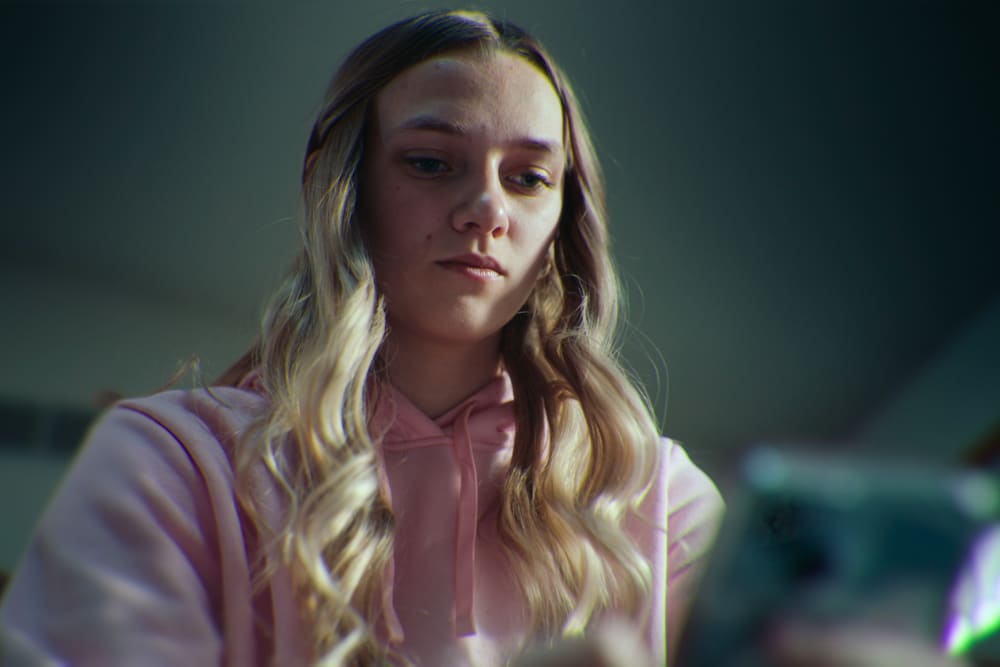The most brutal moments in Netflix’s new documentary “Unknown Number: The High School Catfish” are fleeting. They occur when our main character Lauryn Licari, blond, soft-spoken and, according to her father, a great athlete, casts her eyes downward in pain. They occur as Licari sits on a floral bedspread in her high school bedroom, brimming with emotion that never fully surfaces, recounting the relentless anonymous cyberbullying she endured for almost two years.
Beginning in October 2020, 13-year-old Lauryn and her then-boyfriend and fellow high school student Owen McKenney began receiving increasingly aggressive text messages from an anonymous number. The messages escalated. At times, Lauryn would field 40 or 50 messages in a single day, some even urging her to take her own life.
At times, Lauryn would field 40 or 50 messages in a single day, some even urging her to take her own life.
In December 2022, the FBI uncovered who was behind the texts. To the shock of everyone in their small Michigan town, it was, and this is a spoiler, Lauryn’s own mother, Kendra Licari.
Kendra was charged with two counts of stalking a minor, two counts of communicating with another to commit a crime and one count of obstruction of justice (she pleaded guilty to two counts of stalking a minor in March 2023, and the other charges were dismissed). She was released on parole in 2024.
The documentary posits that Kendra suffers from a sort of cyber Munchausen by proxy, also called “factitious disorder imposed on another,” a complex mental health disorder in which a caregiver fabricates the appearance of health issues ostensibly for attention, sympathy or a pathological desire to deceive. Although rare, the disorder has become widely known from high-profile cases like Gypsy Rose and Dee Dee Blanchard and from popular works of fiction like “Sharp Objects” by Gillian Flynn.
As I’ve mentioned in other columns, my husband and I don’t have children yet. But one conversation we have often is about what kind of parents we’ll be. When we watched “Unknown Number” together earlier this week, we discovered it isn’t the sort of documentary that offers a clear solution to a systemic problem. In many ways, “Unknown Number” explores the tragic, singular story of a mother’s psychosis at the expense of her daughter. Except in one salient way: the harm caused by the unrestricted access so many kids have to smartphones — specifically in schools.
To me, “Unknown Number” offers compelling anecdotal evidence that cellphones should be, at best, entirely banned from school or, at worst, severely limited there. I know the shocking end to this story would not have been softened by limited cellphone use during school hours, but it would have made the cyberbullying ordeal far less fully encompassing. It could have protected Lauryn, Drew and the number of students sucked into the orbit of this disaster to some degree.
About 15 minutes into the documentary, Drew’s mother, Jill, recounts begging the Beal City High School administration to limit cellphone access during school hours. “I can’t tell you the countless times just standing in the principal’s office, in tears, going, ‘Can we please enforce a cellphone policy?’” She went on to ask, prudently and rhetorically, “Why does my kid have access to look at this when he should be learning?”
I’m reticent to ever blame teachers or school administrators for our kids’ problems. I will always point out that educators in this country are woefully underpaid and subjected to entitled and unbridled commentary that is often judgmental and rude. Yet the response that Bill Chilman, the superintendent at Beal City Public Schools, offered to Jill feels contrived, disingenuous and frustrating. “I’m kind of all over the board with kids having phones at school, because our cellphones… I mean, I use mine as a personal office. I work a lot from my phone. You know, I know they can be used in a classroom as an educational tool.” This reasoning treats cellphones as neutral instruments, ignoring how easily they are weaponized in the hands of a bully, and the extent of harmful information they can transmit directly to young people.












